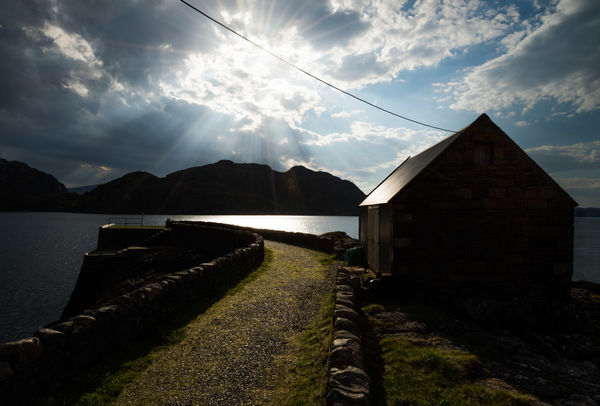How does an HDR photo compare to a RAW photo?
Mar 1, 2021 15:49:21 #
Mar 1, 2021 15:57:31 #
They are both image files, but they are not the same thing, so this is not an apples to apples comparative question.
Mar 1, 2021 16:54:05 #
julian.gang wrote:
Is it better or worse, or pretty much the same thing?...Julian
They are not the same thing or even very close.
RAW is the data as seen/recorded by the camera - equivalent of a negative in film days. It has to be processed.
HDR is almost always blended jpegs* each at a different exposure level. Though I have done HDR (for fun & experiment) by shooting RAW frames and then processing and blending them in LR and PS. But most people like the in camera "automatic" HDR which as far as I know all cameras do those as jpeg.
* Usually 3 or more, if three one is exposed for the shadows, one for the mid tones and one for the highlights.
Mar 2, 2021 05:18:28 #
It is true that you have a lot more possibility of recovering detail in shadows and, to a more limited extent, in highlights than with a tiff or jpg, but it is still a single exposure and cannot compare with the dynamic range possible with bracketed exposures combined.
Mar 2, 2021 05:52:14 #
julian.gang wrote:
Is it better or worse, or pretty much the same thing?...Julian
In modern, wide dynamic range cameras single raw captures can often work in most circumstances. Many cameras can capture 10 stops or more of dynamic range and raw converters can handle 5 or so stops of compression with natural tone mapping. HDR opens that up to as much as 15-20 stops of capture dynamic range as 32 bit files, though they are still limited to the 5-7 stops of dynamic range visible in print, projection and digital display.
Both are valid, and HDR has an advantage with static subjects, while wide-dynamic range cameras can do it in a single image, making them ideal for capture of wide dynamic range active subjects.
Raw is not the same as HDR, and whether you choose one over the other is dependent on subject material.
Mar 2, 2021 08:51:16 #
julian.gang from your recent post...
"I just read on the walmart web site that combining a polarizing filte, a UV filter, and a close-up filter will create an HDR effect on the photo taken is this correct?...Julian"
Julian to be honest, High Dynamic Range means many things to many people... My sincere advice is to invest some serious time on software developer Photomatix's web portal... Below is a link to their web portal...
https://www.hdrsoft.com/ click on "Lean about HDR"
I have been using Photomax Pro for over a decade with my commercial work...
My clients are pleased, at the end of the day nothing else matters.
Photomax Pro is an industry standard... As such you might pay little attention to UHH opinions that lack corroboration. UHH is sadly overrun with "Taking Heads" who post no validation imagery to authenticate inferences...
Below is an example of deploying Photomax Pro in a "High Contrast" scenario.
It is merely another stellar software tool for advanced users... It works well, far better than Adobe's HDR variant.
Hope this helps julian.gang... This tool is available in a free trial download... Try it, k?
.
"I just read on the walmart web site that combining a polarizing filte, a UV filter, and a close-up filter will create an HDR effect on the photo taken is this correct?...Julian"
Julian to be honest, High Dynamic Range means many things to many people... My sincere advice is to invest some serious time on software developer Photomatix's web portal... Below is a link to their web portal...
https://www.hdrsoft.com/ click on "Lean about HDR"
I have been using Photomax Pro for over a decade with my commercial work...
My clients are pleased, at the end of the day nothing else matters.
Photomax Pro is an industry standard... As such you might pay little attention to UHH opinions that lack corroboration. UHH is sadly overrun with "Taking Heads" who post no validation imagery to authenticate inferences...
Below is an example of deploying Photomax Pro in a "High Contrast" scenario.
It is merely another stellar software tool for advanced users... It works well, far better than Adobe's HDR variant.
Hope this helps julian.gang... This tool is available in a free trial download... Try it, k?
.
Mar 2, 2021 09:03:26 #
Thomas902 wrote:
julian.gang from your recent post... br br &quo... (show quote)
Thanks I will check this out!...Julian
Mar 2, 2021 09:07:42 #
If by "HDR" you mean in-camera HDR, you will be limited to jpeg only. However, it's possible to do your own HDR by using exposure bracketing which gives you the option of saving raw files - but you need merging software to merge the resulting 3, 5 or 7 files. The product of an HDR merge is a file that is data-rich and that can be given a lot of pushing and pulling in post processing. That's true of merged jpegs but it is especially true of merged raw files.
Exposure bracketing also gives you a fair amount of protection from blown highlights - not 100% protection but it has to be reeeealy extreme before you get caught out, and you can increase the protection by combining bracketing with exposure compensation (if it's reeeeeeeeeealy extreme ).
).
.
Exposure bracketing also gives you a fair amount of protection from blown highlights - not 100% protection but it has to be reeeealy extreme before you get caught out, and you can increase the protection by combining bracketing with exposure compensation (if it's reeeeeeeeeealy extreme
 ).
)..
Mar 2, 2021 09:16:31 #
Picture Taker
Loc: Michigan Thumb
I have over the years been playing with HDR. I now find that I shoot JPG and bulk process on Photomatix and the do any software fixes. I am sure I will be challenged for this approach but that's what I do and we all do it our own way. Just have fun.
Mar 2, 2021 09:47:14 #
As someone said, the term means different things to different people/ hardware or software. But if one means stretching the dynamic range of a photo by some means, my best example would be astro photos. Even loading raw into many packages, an image of a galaxy can show no galaxy at all, just the bright star field around it. These stars are few in number, but maybe a 100 to several hundred times as bright as the galaxy and most of the packages I've tried, including PS, only see the stars in making a jpeg automatically. The ones I have come from an automated scope which provides both a jpeg and raw (tiff and/or fits), but I assume a DSLR would be similar.
For solar eclipses (total), it is recommended to take the multi-shot, different exposure approach to get the corona. While you can visually see the corona at totality, you only see the brightest part and it is actually much greater in extent.
Hope this helps some;
Jim
For solar eclipses (total), it is recommended to take the multi-shot, different exposure approach to get the corona. While you can visually see the corona at totality, you only see the brightest part and it is actually much greater in extent.
Hope this helps some;
Jim
Mar 2, 2021 09:59:31 #
Picture Taker wrote:
I have over the years been playing with HDR. I now find that I shoot JPG and bulk process on Photomatix and the do any software fixes. I am sure I will be challenged for this approach but that's what I do and we all do it our own way. Just have fun.
When you can fully fit the scene range into a jpg such that only very minor tweaking (basically “to taste”) is all thaz needed, then your jpg is a great finished image. Acoarst there can be no harm in shooting raw+jpg cuz the raw files are good “insurance” in tricky situations.
That said, if in-camera HDR results in a great result you already have a finished product. But if time permits, after the HDR is in the can you can make some bracketed raw shots before the moon drops below the half dome ;-) Thaz clearly what The Hat Man would have done today !
Mar 2, 2021 11:38:51 #
photoman022
Loc: Manchester CT USA
I shoot in RAW, exposing for the highlights, and will edit that single file to bring out the details in the shadows, then combine the multiple photos (2 or more--usually 5) in Photoshop Elements for an HDR (High Dynamic Range) photo. That photo is usually a pretty good representation of what I saw when I took the photo.
I do it this way in order to avoid "ghosting" which occurs when the wind blows when taking multiple exposures. I understand that Photoshop can overcome ghosting, but Elements cannot (at least the version I use).
I do it this way in order to avoid "ghosting" which occurs when the wind blows when taking multiple exposures. I understand that Photoshop can overcome ghosting, but Elements cannot (at least the version I use).
Mar 2, 2021 11:49:38 #
kymarto wrote:
It is true that you have a lot more possibility of recovering detail in shadows and, to a more limited extent, in highlights than with a tiff or jpg, but it is still a single exposure and cannot compare with the dynamic range possible with bracketed exposures combined.
Can you merge as JPEGs and then save/print as TIFF?...Julian
Mar 2, 2021 12:19:02 #
Thomas902 wrote:
julian.gang from your recent post... br br &quo... (show quote)
Photomatix, not Photomax
Mar 2, 2021 13:03:53 #
mwsilvers
Loc: Central New Jersey
julian.gang wrote:
Is it better or worse, or pretty much the same thing?...Julian
I rarely find the need to create HDR images these days. I have much better success with well exposed raw files edited in software with strong local adjustment capabilities and good noise reduction. I personally use Photolab 4 Elite.
Good local adjustment control on a raw image can pull shadow detail from various places in an image without affecting the overall image. At the same time It can also bring out much more detail in the sky and reduce overly bright areas, again without affecting the rest of the image.
Since pulling detail from shadows can increase the noise in those areas of the image, a good noise reduction feature is important.
For me the end result are much more natural looking images. While, of course, some programs are much better than others for creating HDR, many if not most HDR images don't look natural to my eyes.
The main limitation of shooting multiple images for HDR is the requirement for a completely static subject. Even a gentle breeze or any movement of an animal or other object will be very obvious when three to five images have to be captured and overlaid.
If you want to reply, then register here. Registration is free and your account is created instantly, so you can post right away.







